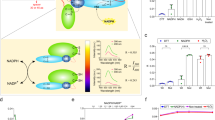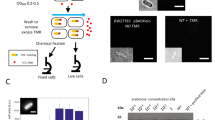Abstract
Genetically encoded fluorescent sensors can be valuable tools for studying the abundance and flux of molecules in living cells. We recently developed a novel class of sensors composed of RNAs that can be used to detect diverse small molecules and untagged proteins. These sensors are based on Spinach, an RNA mimic of GFP, and they have successfully been used to image several metabolites and proteins in living bacteria. Here we discuss the generation and optimization of these Spinach-based sensors, which, unlike most currently available genetically encoded reporters, can be readily generated to any target of interest. We also provide a detailed protocol for imaging ADP dynamics in living Escherichia coli after a change from glucose-containing medium to other carbon sources. The entire procedure typically takes ∼4 d including bacteria transformation and image analysis. The majority of this protocol is applicable to sensing other metabolites and proteins in living bacteria.
This is a preview of subscription content, access via your institution
Access options
Subscribe to this journal
Receive 12 print issues and online access
$259.00 per year
only $21.58 per issue
Buy this article
- Purchase on Springer Link
- Instant access to full article PDF
Prices may be subject to local taxes which are calculated during checkout





Similar content being viewed by others
References
Paige, J.S., Wu, K.Y. & Jaffrey, S.R. RNA mimics of green fluorescent protein. Science 333, 642–646 (2011).
Paige, J.S., Nguyen-Duc, T., Song, W. & Jaffrey, S.R. Fluorescence imaging of cellular metabolites with RNA. Science 335, 1194 (2012).
Song, W., Strack, R.L. & Jaffrey, S.R. Imaging bacterial protein expression using genetically encoded RNA sensors. Nat. Methods 10, 873–875 (2013).
Strack, R.L. & Jaffrey, S.R. New approaches for sensing metabolites and proteins in live cells using RNA. Curr. Opin. Chem. Biol. 17, 651–655 (2013).
Ellington, A.D. & Szostak, J.W. In vitro selection of RNA molecules that bind specific ligands. Nature 346, 818–822 (1990).
Stoltenburg, R., Reinemann, C. & Strehlitz, B. SELEX—a (r)evolutionary method to generate high-affinity nucleic acid ligands. Biomol. Eng. 24, 381–403 (2007).
Zhang, J., Campbell, R.E., Ting, A.Y. & Tsien, R.Y. Creating new fluorescent probes for cell biology. Nat. Rev. Mol. Cell Biol. 3, 906–918 (2002).
Frommer, W.B., Davidson, M.W. & Campbell, R.E. Genetically encoded biosensors based on engineered fluorescent proteins. Chem. Soc. Rev. 38, 2833–2841 (2009).
Ibraheem, A. & Campbell, R.E. Designs and applications of fluorescent protein-based biosensors. Curr. Opin. Chem. Biol. 14, 30–36 (2010).
Kellenberger, C.A., Wilson, S.C., Sales-Lee, J. & Hammond, M.C. RNA-based fluorescent biosensors for live-cell imaging of second messengers cyclic di-GMP and cyclic AMP-GMP. J. Am. Chem. Soc. 135, 4906–4909 (2013).
Nakayama, S., Luo, Y., Zhou, J., Dayie, T.K. & Sintim, H.O. Nanomolar fluorescent detection of c-di-GMP using a modular aptamer strategy. Chem. Commun. (Camb) 48, 9059–9061 (2012).
Buckstein, M.H., He, J. & Rubin, H. Characterization of nucleotide pools as a function of physiological state in Escherichia coli. J. Bacteriol. 190, 718–726 (2008).
Jenison, R.D., Gill, S.C., Pardi, A. & Polisky, B. High-resolution molecular discrimination by RNA. Science 263, 1425–1429 (1994).
Srinivasan, J. et al. ADP-specific sensors enable universal assay of protein kinase activity. Chem. Biol. 11, 499–508 (2004).
Ponchon, L. & Dardel, F. Recombinant RNA technology: the tRNA scaffold. Nat. Methods 4, 571–576 (2007).
Gottschalk, P.G. & Dunn, J.R. The five-parameter logistic: a characterization and comparison with the four-parameter logistic. Anal. Biochem. 343, 54–65 (2005).
McCombs, J.E. & Palmer, A.E. Measuring calcium dynamics in living cells with genetically encodable calcium indicators. Methods 46, 152–159 (2008).
Cozzone, A.J. Regulation of acetate metabolism by protein phosphorylation in enteric bacteria. Annu. Rev. Microbiol. 52, 127–164 (1998).
Lowary, P.T. & Uhlenbeck, O.C. An RNA mutation that increases the affinity of an RNA-protein interaction. Nucleic Acids Res. 15, 10483–10493 (1987).
Lowry, O.H., Carter, J., Ward, J.B. & Glaser, L. The effect of carbon and nitrogen sources on the level of metabolic intermediates in Escherichia coli. J. Biol. Chem. 246, 6511–6521 (1971).
Acknowledgements
We thank J.S. Paige and T. Nguyen-Duc for helpful suggestions and Jaffrey lab members for constructive comments on the manuscript. This work was supported by the US National Institutes of Health (NIH) National Institute of General Medical Sciences (NIGMS) grant nos. F32GM106683 (R.L.S.) and R01EB010249 (S.R.J.).
Author information
Authors and Affiliations
Contributions
R.L.S., W.S. and S.R.J. conceived the experiments. W.S. had a major role in the development of the Spinach-based sensors. R.L.S. carried out imaging experiments and optimized the imaging protocol. R.L.S. and S.R.J. wrote the manuscript.
Corresponding author
Ethics declarations
Competing interests
W.S. and S.R.J. are authors of a US patent application regarding the sensors described in this manuscript.
Rights and permissions
About this article
Cite this article
Strack, R., Song, W. & Jaffrey, S. Using Spinach-based sensors for fluorescence imaging of intracellular metabolites and proteins in living bacteria. Nat Protoc 9, 146–155 (2014). https://doi.org/10.1038/nprot.2014.001
Published:
Issue Date:
DOI: https://doi.org/10.1038/nprot.2014.001
This article is cited by
-
Nucleic acid-based fluorescent sensor systems: a review
Polymer Journal (2022)
-
Cell Rover—a miniaturized magnetostrictive antenna for wireless operation inside living cells
Nature Communications (2022)
-
Pocket MUSE: an affordable, versatile and high-performance fluorescence microscope using a smartphone
Communications Biology (2021)
-
Highly efficient expression of circular RNA aptamers in cells using autocatalytic transcripts
Nature Biotechnology (2019)
-
Isothermal folding of a light-up bio-orthogonal RNA origami nanoribbon
Scientific Reports (2018)
Comments
By submitting a comment you agree to abide by our Terms and Community Guidelines. If you find something abusive or that does not comply with our terms or guidelines please flag it as inappropriate.



